

|
by Joseph Brennan. Copyright 2001, 2002. |
19 StPassenger service: February 1908 - August 1954.Existing abandoned portions: 2 platforms (on tracks in service). Touring: PATH trains, running between 14 St and 23 St. Look out the front windows or right side windows. 28 StPassenger service: November 1910 - December 1937.Existing abandoned portions: Traces of platform and ceiling edges. Touring: PATH trains, running between 23 St and 33 St. Look out the front windows and watch on the right side for changes in the bench marking the former platform edge and especially traces of the former arched openings at ceiling height. construction and operationThe Hudson and Manhattan Railroad opened their privately financed subway between New York and New Jersey in 1908-1910. The first section open was from 19 St to Hoboken Terminal, in February 1908. 19 St was only a temporary terminal while construction continued up 6 Ave, opening to 23 St in June of the same year, and through to the 33 St terminal in December 1910. The subway in 6 Ave was built cut and cover north of 12 St, in contrast to the shield tunnel lined with iron rings that is the distinctive characteristic of most of the system once known as the "Hudson Tubes". The walls and roof were built by the new construction technique of concrete with embedded "rebar" reenforcing rods, presenting a smooth surface. At station platforms, there was a line of thick round columns supporting an arched ceiling, visible today (with renovation) at the open stations 23 St and 14 St. The cross streets chosen for stations were about the same ones as on the subway and elevated lines. 14 St, 23 St, and 34 St were major crosstown streets with streetcar lines. Although there was a less important crosstown car in 28 and 29 Sts, the two intermediate stations at 19 St and 28 St were probably built mainly to reduce spacing to a quarter mile. Why 19 St was chosen, instead of 18 St as on other lines, is unknown. The H & M tunnels occupied one of the major avenues of Manhattan. In the franchise given by the City to the New York and Jersey Railroad in 1905, the City reserved the right to purchase the tunnel in 6 Ave to use for "a municipal system of rapid transit". The City exercised this right in 1936, purchasing the "property rights" and then making certain alterations to the route. The Board of Transportation began construction of the 6 Ave subway in 1936, building around the H & M tunnels. From 13 St to about 26 St, the 6 Ave subway local tracks run on either side of the H & M tunnels at a somewhat lower level. (The 6 Ave express tracks, which run under the H & M tunnels, were built 1961-1968.) Four of the stations were altered: 14 St H & M station was slightly resited to the south, keeping the central portion of the platform, but closing the old north end and opening a new south end. At the new north end, located at 14 St itself, is a new entrance shared with the 6 Ave subway. The 6 Ave subway station runs from 14 St north to 18 St. 19 St station was not altered because the 6 Ave subway was located below the grade of the H & M at this point. At 23 St H & M station, the original entrances and part of the platform space were destroyed by 6 Ave subway work. The new access was an underpass from each H & M platform passing under the subway track and up to a shared entrance with the subway station at platform level. The 28 St H & M station was completely destroyed. It is listed here because some trace of it can still be seen. The bench along the right-hand tunnel wall is slightly higher marking the old platform edge. The ceiling arches between the platform columns, as they run out to meet the arch over the tracks, can still be seen. The original 33 St H & M terminal was also completely destroyed. Both 28 St and 33 St closed in December 1937. The new 33 St terminal opened in September 1939 on a new site. It is a little higher than track level of the old station, to allow the 6 Ave subway to slip directly underneath and over the Penn Station tunnels in 32 St and 33 St. It is also a block further south. The old name was kept, but it actually runs from 32 St to almost 30 St. The 30 St entrance was offered as partial justification for closing 28 St. The new end of track at 32 St allowed adequate space for pedestrian passages at the same level into the subway station mezzanines. There is an odd trace of the old 33 St terminal: the downtown side of the Broadway subway 34 St station dips lower than the uptown side, to pass under the former location of the 33 St H & M terminal. The 19 St station lasted until 1954, when it was finally closed simply to speed service. The midtown business, shopping, and theater districts had gradually moved northward. A curiosity was that the advertising posters from 1954 remained visible from passing trains for forty years afterwards. In 1994-1996, emergency tunnel ventilation fans were installed on the platform and part of the platform area was walled up, but much of it can still be seen. |
diagram
The 28 St station site is immediately south of the switches leading to the 33 St station. A gap in the center wall north of 19 St was used to cross over trains while 19 St and 23 St were the terminals in 1908-1910, and again in 1937-1939 when 23 St was again the terminal. There is no crossover now. South of 14 St, the tunnel drops, and the tracks separate to allow for the two bored tunnels lined with cast iron rings. At 9 St curve, there are headings for a level junction with a never-built branch line that would have run in 9 St to end at the subway in Lafayette St. Just past 9 St is space for another crossover. 9 St station is much deeper than 14 St. |
|
|
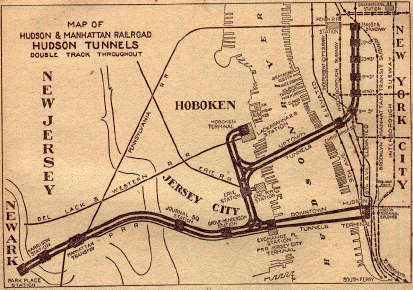
|
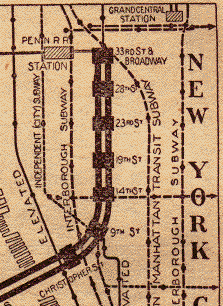
The Hudson and Manhattan Railroad always took a page in The Official Guide of the Railways and included a map. Shown here from the December 1934 issue is the map in original size together with an enlarged detail to show among others 19 St and 28 St stations. |
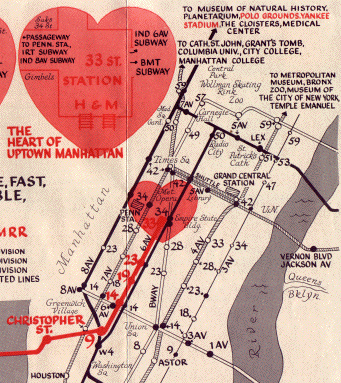
A Hudson and Manhattan brochure, Hudson Tube Recreation Guide, circa 1950, included a hand-drawn map that shows 19 St station. |
|
|
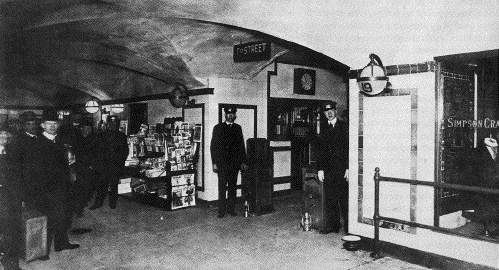
|
An oft-reproduced photo shows 19 St station in 1908. Two railroad employees man the ticket choppers, with oil lanterns ready on the floor in front of the choppers. Between and behind them, at least one more employee works a ticket office behind grilled windows. Note the light fixtures with '19' painted on, and the official spittoon provided on the floor near the right. All the stations from 14 St north had these ceiling arches. Hudson and Manhattan Railroad. |
|
|
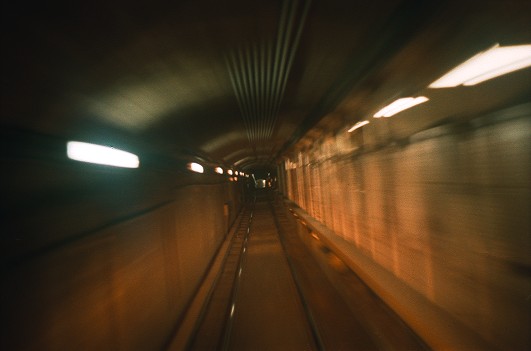
|
19 St station, from a train running toward 33 St, 2001. |
|
|
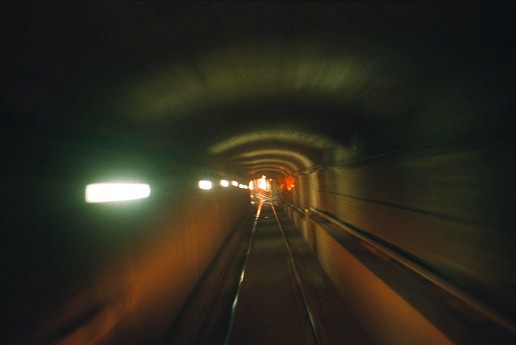
|
The remains of 28 St station, from a train running toward 33 St, 2001. The higher bench in the foreground is the platform edge. The arches (see the old 19 St photo above) are too blurred to see in this image. The bright light of 33 St station is just ahead. |
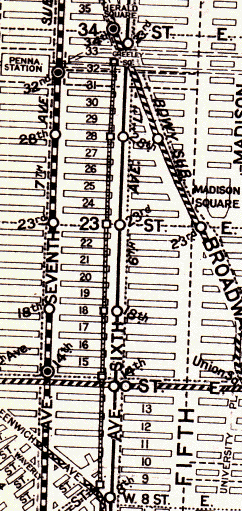
The Geographia map accompanying the Complete Street Guide to New York of 1939 still shows 28 St, and erroneously shows 19 St station located at 18 St. The solid black line in the center of 6 Ave is not the subway, but the 6 Ave El, which had closed in 1938. The H & M looks like a later addition to the map, placed west of 6 Ave and drawn with the Hagstrom map convention of square station symbols to differentiate it from other subway routes. |
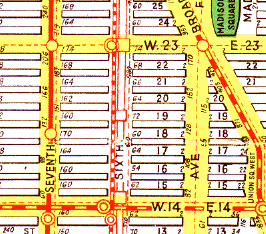
A Hagstrom map of 1945 shows 19 St station in the right place, and has the H & M down the middle of 6 Ave. The 6 Ave subway was a later addition to the 1934 map design, and has been inserted along the west side of the H & M in a somewhat awkward fashion compared to the sure hand of the original map elements. The 6 Ave subway stations are shown as express stops because the subway was a two track line between 34 St and West 4 St until 1968. |
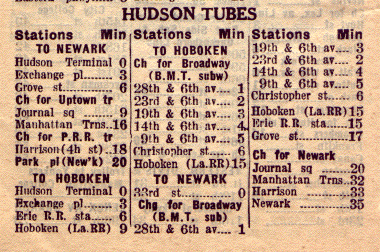
An excerpt from the 1928 Red Book guide to Brooklyn lists the 19 St and 28 St stations. |